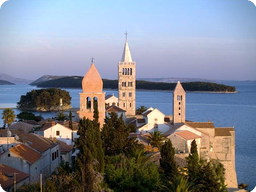

Rab/island of Rab
Rab/island of Rab  Rab fjera
Rab fjera
Rab fjera
25 July-27 July 2009
Rab fjera was an event organized by the citizens of Rab to present their rich and famous history to tourists. It earned the "Blue flower" award of the Croatian Tourism Board. Islanders, dressed up in costumes try to give an authentic presentation of the life of their ancestors.
Rab fjera has its origins in the Rab High Council Decree of 21 July 1364, which proclaimed 9 May as Dies Victoriae, a town holiday celebrating the town’s miraculous defence against the Normans following the intercession of St Christopher. 27 July, Dies Natalis, the day of his martyrdom was also proclaimed a holiday. It was decreed that the fjera was to be marked by the cessation of judicial proceedings and the prosecution of debtors for fifteen days. The festivities were introduced in honour of King Ludwig the Great, who freed Rab from the Venetians. They lasted for seven days in the season of the holidays of St Jacob, St Anthony and St Christopher. During these festivities, Rab became a city of felicity, which can be seen in the name that it had had since the 3rd century – Felix.
In the beginning, the fjera was celebrated at weekends. However it has been decided to stick to tradition and it is now celebrated on holiday dates. What the people of Rab have managed to achieve is to turn Rab into a medieval stage. Every year, there are more and more workshops demonstrating the art of old crafts and trades. Medieval craftsmen and tradesmen make coins, plates, glasses, stones, barrels, scissors and shoes. They also comb wool, write names and notes in glagolitic script, and paint on silk. Bread baked under a lid is served with local prosciutto ham, cheese and wine. More complicated dishes made to traditional recipes, such as lamb tripe, are also served.
Source: http://www.villas-rab.com/
Video
Current news
 Macrocruise charter agency
Additional discount on the boat rental price of betw
Macrocruise charter agency
Additional discount on the boat rental price of betw






























